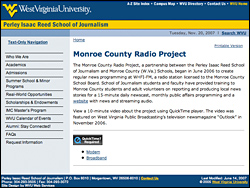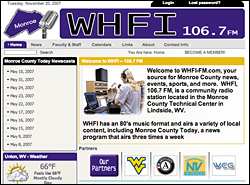The coordinators of the Monroe County Radio Project have learned that getting a regular radio news broadcast on the air is easier dreamed than done.
 While they have achieved their primary goal of developing a news presence on community radio station WHFI-FM, multiple staff transitions and the university’s four-hour driving distance from the isolated rural county are proving to be barriers to stability for the project. WHFI broadcast regular local news programming nearly every week over a 10-month period through May 2007. Then it took a hiatus over the summer and it’s been difficult to get going again.
While they have achieved their primary goal of developing a news presence on community radio station WHFI-FM, multiple staff transitions and the university’s four-hour driving distance from the isolated rural county are proving to be barriers to stability for the project. WHFI broadcast regular local news programming nearly every week over a 10-month period through May 2007. Then it took a hiatus over the summer and it’s been difficult to get going again.
In its first year:
- WHFI broadcast 82 original “Monroe County Today” newscasts, which included a mix of hard news, community calendars, and minute-long features about health, agriculture, cooking and careers.
- WHFI reporters regularly covered public meetings, some of which had never before been covered by journalists, including County Commission, Board of Education and the Peterstown Town Council and Union Town Council meetings.
- The WVU School of Journalism trained more than 20 high school students and community volunteers how to report, write and produce radio news stories. WVU students conducted two extensive training sessions in Monroe County and provided feedback throughout the school year. Some of the WVU students were enrolled in a course created to support the project, titled “Community Radio Journalism.”
- WVU journalism students produced an average of two stories a month for WHFI about issues of importance to Monroe County residents.
Project Director Maryanne Reed, dean of WVU’s School of Journalism, said it was “satisfying to see some of our volunteer reporters grow as journalists.” A high school junior eventually became the station’s primary news anchor. And a VISTA volunteer who traveled to Virginia Tech to cover the mass shootings produced an 18-minute special report on the tragedy.
 The station launched a website, where Monroe County Today’s newscasts were posted three times a week until it paused production May 31, 2007 (coinciding with the end of the school year) because of staff losses on the local level. In the fall they started again, airing two productions a week. While the new website invites community members to offer story ideas, announcements, feedback, and gives visitors the opportunity to sign on as volunteer reporters, Reed says many county residents do not have high-speed Internet access, so the focus on radio broadcasting will continue to take priority.
The station launched a website, where Monroe County Today’s newscasts were posted three times a week until it paused production May 31, 2007 (coinciding with the end of the school year) because of staff losses on the local level. In the fall they started again, airing two productions a week. While the new website invites community members to offer story ideas, announcements, feedback, and gives visitors the opportunity to sign on as volunteer reporters, Reed says many county residents do not have high-speed Internet access, so the focus on radio broadcasting will continue to take priority.
As they sought to ramp up again this fall, the project has been plagued by difficulties communicating with the school district. They’ve also been unable to hire a VISTA volunteer. They did hire a West Virginia graduate as a part-time station manager and were airing two news programs per week.
Looking back, Reed says, “I think we were overly ambitious about what could realistically be accomplished in a single year. Research about community radio suggests that creating a viable community radio news operation can take several years—particularly when stations receive little public financing.”
Among other challenges was the geographical distance between campus and the station. That distance strained relationships, making it hard to build editorial trust. “At first, the news team in Monroe County viewed our written feedback as being highly critical and as a result, demoralizing,” says Reed. “When we began giving the feedback in weekly phone conferences, there was more of a two-way exchange, and our suggestions were better received.”
Looking ahead, WVU still aims to help the station produce a sustainable 5-day- a-week news program. In order to get back on track, the university has hired WVU Instructor and former West Virginia Public Radio correspondent Emily Corio to train a new VISTA reporter and integrate WVU students into the production at WHFI. The University hopes the Monroe County Technical Center, which runs the station, will hire a new high school teacher to recruit and train high school volunteers. But the project will put greater emphasis on training adults from the community to become citizen reporters. A journalism master’s student has committed to creating a public awareness campaign to solicit community volunteers.



